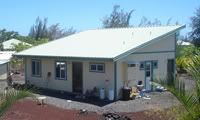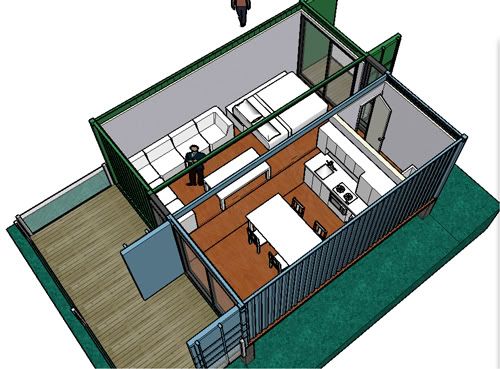Devised by Pak & Associates LLC and Sponsored by PREIT Inc, Aloha Block™ is a simple and efficient modular system that creates affordable accommodation for a wide range of uses.
Enjoy Your Sweet Home, Efficient Office and/or Easy Storage Modified by Containers for in LOHAS Ways, with Full Support from a Professional Team Hawaii in Sustainable Inteior Design, Eco-Friendly Fit-Out, Innovative Architecture and Top-Notch Engineering, while Sharing Inspired Ideas and Best Practices Across the Globe on Green Accommodation to Benefit Our Future Generations.
Hardy Island Beach House


Hardy Island Beach House
Hardy Island Beach House is located in Vancouver, BC, Canada
The design proposal features 7, 20 foot containers with a great room facing the ocean,two lofts above for the kids and a master bedroom facing the back of the property.
Out the master bedroom deck is a hot tub which is standing on a piling with a fireplace at the ground level so the water can be heated naturally by firewood. A circulating pump keeps things cozy.
Container House, Atlanta
Atlanta Shipping Container House
These 32,000 pound containers, which decades ago shipped everything from furniture to clothes overseas, are now all sitting around taking up space.
These 32,000 pound containers, which decades ago shipped everything from furniture to clothes overseas, are now all sitting around taking up space.
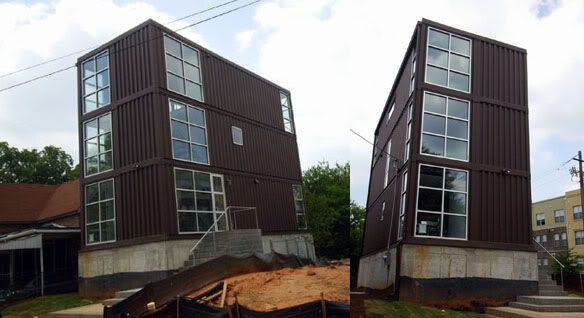
Except, of course, for those that are being used to build disaster relief shelters or affordable housing, like this 1,920 square foot three-container structure in Atlanta.
What this place shows is one of the many outside-the-box design possibilities for these recycled containers. They can be stacked, laid side by side or arranged in less symmetrical and more creative ways. As a basic building block, the possibilities are pretty much endless. And all it takes is minor modifications — i.e., cutting out windows, like you see here — to make it your own.
Better still, the containers protect against hurricanes, tornadoes, earthquakes and fires — and termites hate ‘em.
And down the line, when you need more space — just have another one shipped to you. It’s that easy.
This house, spotted on materialicious, was reportedly designed by Soren Ludwig of Global Peace Containers. If you haven’t seen their site, I highly recommend it.
They’re a not-for-profit org working to produce “sustainable housing and community buildings such as medical facilities, schools and neighborhood centers” out of retired containers.
Shipping container house. I want one. And I know you do, too.
Keetwonen, Amsterdam

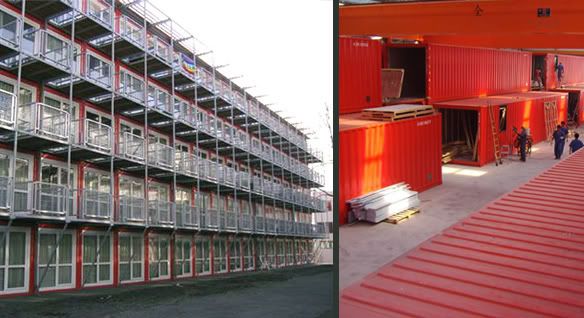

Keetwonen by TempoHousing, Amsterdam, The Netherlands
I’ve heard of students roughing it, but sleeping in freight containers? That’s right. Only it’s not a case of desperate living or some torturous fraternity hazing — it’s a very cool,very useful idea developed by a Dutch company called TempoHousing.
First conceived in the 1930s, the ISO dry freight container has been the universal shipping receptacle worldwide for the past fifty years. You’ve no doubt seen thousands of them in your lifetime.
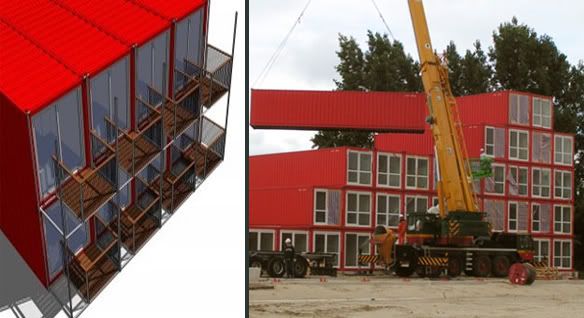
But could you live in one? Before you say “No way, it’s too small” or “it’s too boring”, check this out: with standard dimensions of 40’ x 8’ x 8’6’, the containers can be stacked (a whopping 8,000 can fit on a large ship) and transported anywhere in the world via water, rail or road.
How is it different from a trailer, you ask? Well, for one, thing it’s green.
With millions of these containers in existence — many of them sitting around unused, taking up precious space or rusting away in junkyards — TempoHousing got the brilliant idea to recycle them into livable units. The result is comfortable, fashionable, affordable and can be… you guessed it… shipped anywhere in the world. How cool is that?
Sure, they’re tiny. But each 332.9 square foot unit comes with the standard apartment amenities: kitchen, bathroom with hot water (via a 13.2 gallon boiler), heating (from dual units, one at each end), electrical wiring — even a balcony. Some containers also have windows on the side and air conditioning is available for an additional charge. In addition, a special roof has been added to provide efficient rainwater drainage, insulation and ventilation.
Design-wise, these creations are both smart and innovative. The nearly 26 square foot bathroom contains a special anti-slip floor with an integrated shower base. The doors come with anti-theft hinges and heavy duty locks, while the double-glazed U-value windows are equipped with fall-through safety. And of course, there are smoke detectors.
What I love is the endless potential for growth. The units can exist on their own or be stacked into “blocks” with centralized electricity, phone and internet systems. An entire complex can be easily created, taken down, moved and recreated. It’s sort of like when Laverne, Shirley and all their neighbors and friends moved from Milwaukee to L.A. — only this could actually happen.
It doesn’t end there. In addition to mini-apartments, TempoHousing has converted these containers into cafes, supermarkets and offices. And in the works is a 3-star container hotel (or “cotel”) in Amsterdam. They’ve also come in handy in disaster areas like Pakistan, where fast, easily installable emergency shelters are needed.
But perhaps the coolest application thus far has been Keetwonen, the ultra-hip student housing project completed last year in Amsterdam. 1000 units came together to create a dorm alternative that was comfortable and sustainable.
What makes this concept so incredibly cool is not just that they’re recycling old containers or that you can now take your home with you, it’s TempoHousing’s flexibility and willingness to adapt. Their mission statement (obviously written in Dutch and hastily translated into English) states that “quality housing – everywhere in the world – is a key in improving the quality of life. A low cost but fast solution that will last many years is of essence.” According to their website, their in-house design team is available and eager to discuss your personal housing needs and develop specially tailored solutions to make your freight container unit as comfortable as possible.
Custom design that’s green, cool, easy to set up, durable (at least 20 years), and a good investment to boot? Sounds pretty “G” to me.
To see a cool video about Keetwonen, click here
Lafayette Tower, NYC
87 lafayette street,
city realty posting engine 31 firehouse,
hybrid,
lafayette tower,
lot ek,
New York City,
young woo and associates
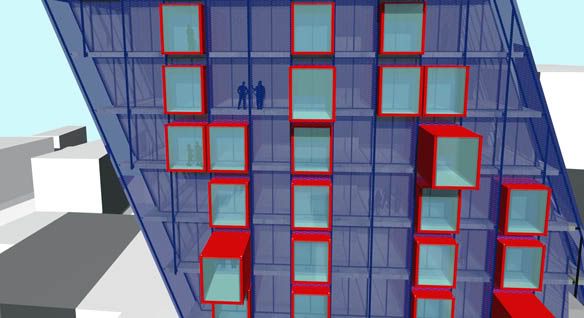
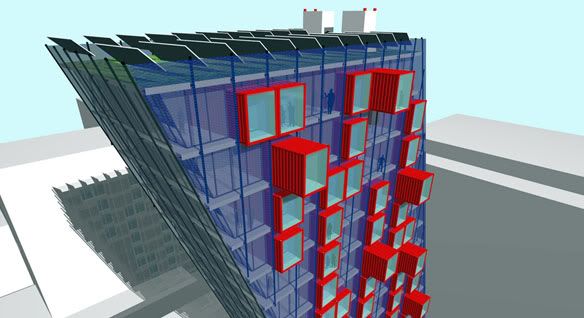
Lafayette Tower A Beautiful Building You May Never See
Those of you who salivate at LOT-EK’s amazing shipping container structures may be wondering whatever happened to the proposed Lafayette Street Tower near New York City’s Chinatown. The building, which received much press last year, was commissioned by Mr. Woo of Young Woo & Associates, who (like me) was intrigued by the design firm’s use of recycled containers in both residential and commercial buildings.
Partially inspired by the industrial feel of the neighborhood, the 19-story tower was slated to be erected at 87 Lafayette Street, adjacent to the city’s former Engine 31 firehouse. The innovative shape was to slant to the north as it grew upward and would utilize shipping containers that protruded from the front in varying degrees. A City Realty posting last year said the base of the building was to be “clad in gunmetal glazed terracotta while the setback tower” was to employ brush stainless steel that would showcase “organic curves while reflecting the area’s industrial past.”
According to LOT-EK, the tower was “a hybrid construction combining a simple concrete slab construction clad in glazing” and “a second skin constructed from a metal mesh” that would provide privacy from the outside while filtering the sun’s rays. “The interstitial spaces between the mesh and glazing, created by a scaffolding-like steel skeleton,” were to “function as semi-private balconies” – which, from the looks of them, would have provided incredible visual access to the bustling city below.
A 3-D effect would be added by the shipping containers, which would feature bathrooms, kitchens and leisure spaces, while an array of solar panels would line the building’s roof.
So, what happened to this amazing structure? A representative from LOT-EK (pronounced “low-tech”), who was kind enough to respond to my query, said it “has been stuck in the city’s building approval process” and at this time is not scheduled to move forward – a regrettably backwards ending to a forward thinking design that could have created new architectural ground and provided a stand-out aesthetic to a visually diverse historic neighborhood.
Here’s to hoping things change for the Lafayette Tower. Just not the design…
CORE House
core house,
darmstadt university,
marmoleum,
plyboo strand,
solar decathlon,
university of colorado,
washington dc

CORE House in Washington D.C., USA
While two-time solar champs, the University of Colorado, didn’t win last year’s Solar Decathlon held in Washington, D.C. with their CORE house, they did place 7th. Is that good enough for these decathletes? Maybe not, but their house is definitely worth talking about. And here’s to hoping they come back in 2009 to kick some more solar ass.
Like many of the designs at the SD, the spine of CORE is made up of shipping containers for ease in transportation and size requirements of the competition — which is about 800 square feet, much smaller than a typical home.
But that’s just the basics. What’s important to know about CORE is that it uses an integrated photovoltaic thermal collection system. Heat collected from the PV not only heats water during the day, it also saves up to heat the house at night. In the summer time, the process works in reverse, making it a more energy efficient system.
The coolest part is the sustainable materials that the CORE house was able to showcase, like Marmoleum (a natural material made of linseed oil, rosin and limestone) and a formaldehyde-free laminated plywood made of bamboo called Plyboo Strand.
Like many of the other homes in the competition, CORE has an awesome aesthetic and is a prototype that could and should go into mass production. I just couldn’t find information as to how much this tiny house would actually cost to produce. If it’s anywhere near the price of the 2007 winning home by Darmstadt University – which, as I recall, was over 1 million dollars — these solar competition homes are way out of most homeowner’s leagues. Will it be any different in the future if and when they go into mass production?
LINKS
- Grassroot Institute of Hawaii - Promote Individual Liberty, the Free Market and Limited Accountable Government
- Common Circle - The Leading Ecological Design and Holistic Living School
- The Designers Accord - A Global Coalition of Designers, Educators and Business Leaders, Working Together to Create Positive Environmental and Social Impact
- BusinessGreen.com - News, Comment and Analysis for Low Carbon Economy
- Vertical Garden - By Patrick Blanc Murs Vegetaux
REFERENCES
- Ebook : Good Green Homes
- Ebook : Promoting Sustainable Electricity in Europe
- Ebook : Beyond Green : Toward a Sustainable Art
- Ebook : Steel Designer's Manual
- Ebook : Sustainable Solar Housing: Volume 1 - Strategies and Solutions
- Ebook : The Green House - New Directions in Sustainable Architecture
- Ebook : Wind Energy : Renewable Energy & The Environment
- EBook : Saving The Planet Without Costing The Earth
- Ebook : Modeling the Environment: An Introduction To System Dynamics Modeling Of Environmental Systems
- Ebook : Dictionary of Landscape Architecture & Construction
- Ebook : Build Your Own Electric Vehicle
- EMagazine : The Cottage
- Ebook : Organic Gardening for Dummies
- Ebook : Wind & Solar Power Systems
- Ebook : Handbook of Alternative Fuel Technologies
- Ebook : The Skeptical Environmentalist
- Ebook : Solar Energy Engineering
- Ebook : Be a Successful Green Builder
- Ebook : Basic Environmental Engineering
- Ebook : Green Roof Construction & Maintenance
- Ebook : Green Your Home - All-in-one for Dummies 2009
- Video : Americas Choice - Liberty or Sustainable Development
- Ebook : The Polliniferoused Container
- Ebook : EcoHouse - A Design Guide
- Ebook : Renewable Energy Resources
- Ebook : The Sky's Not Falling
- Ebook : Green Planet - How Plants Keep the Earth Alive





